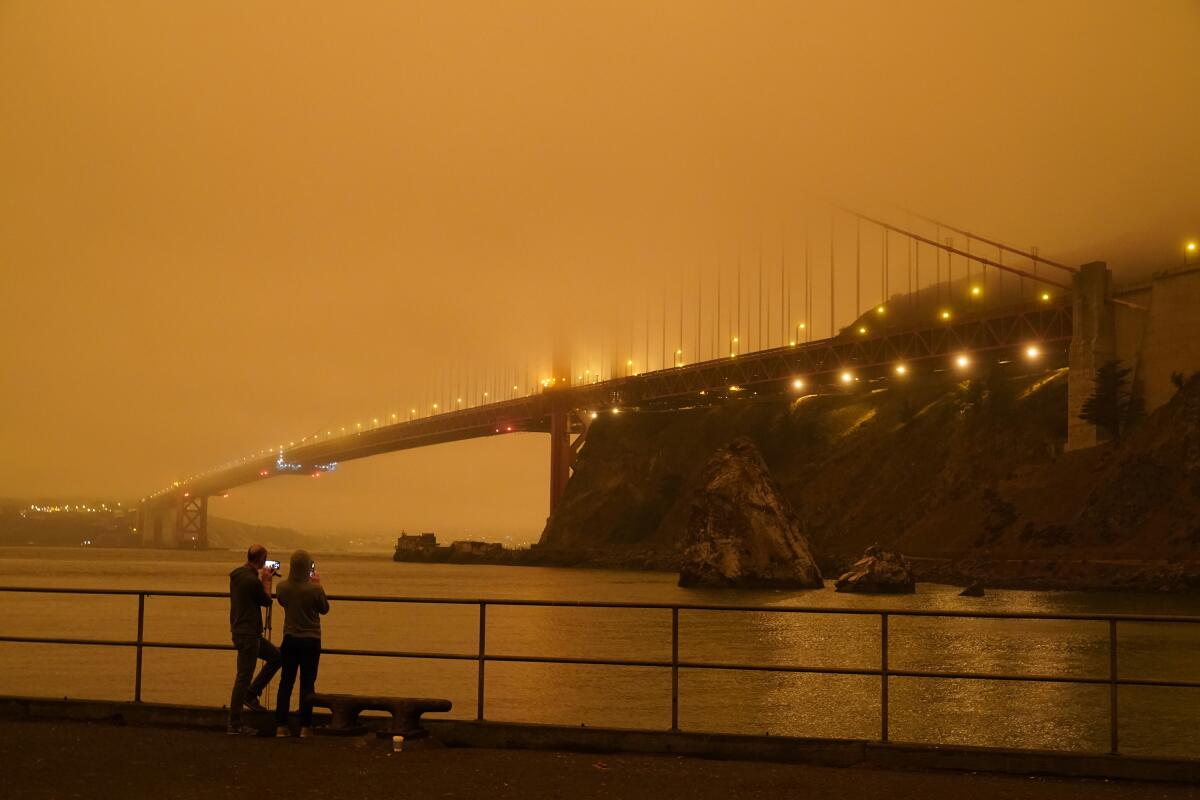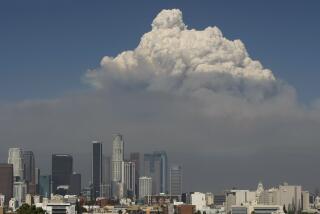Wildfire smoke now causes up to half the fine-particle pollution in Western U.S., study finds

Wildfire smoke now accounts for up to half of all fine-particle pollution in the Western U.S., according to a new study that blames climate change for worsening air quality and health risks in both urban and rural communities in recent years.
The study by researchers at Stanford University and UC San Diego found that the concentration of tiny, lung-damaging pollutants known as PM2.5 that are attributable to wildfire smoke roughly doubled between 2006 and 2018, while the share of pollution from other sources like car and truck exhaust declined.
The trend is most pronounced in Western states and highlights the rapidly growing health threat of wildfire smoke. This became shockingly apparent to millions during last year’s record-breaking firestorm, which enveloped much of the West Coast in an unhealthy pall for weeks.
Levels of PM2.5 had been steadily improving over the last two decades in which they have been routinely monitored, as a result of regulations that have cut emissions from vehicles and power plants. But those gains started to slow, then reverse, over the last decade or so, according to the study.
“The overall picture is of a stalled and reversed improvement, which is a result of other sources getting cleaner and wildfires getting a lot worse,” said Marshall Burke, a professor of Earth system science at Stanford University and lead author of the study published in the Proceedings of the National Academy of Sciences.
The two major factors driving the increase in wildfire smoke are the warming climate and decades of fire suppression that have allowed fuels to build up, according to researchers. They made their estimates by developing a statistical model using fire and smoke data from satellites and readings from ground-based air quality monitoring stations.
Nationwide, wildfires are now responsible for up to 25% of fine-particle pollution, the study found.
“We know wildfires generate smoke. We know smoke is bad for health. But we really didn’t have a comprehensive national picture for how much wildfires are contributing to poor air quality,” Burke said.
Francesca Dominici, a professor of biostatistics at Harvard’s T.H. Chan School of Public Health who was not involved in the research, called it “an excellent study that relies on sophisticated data science approaches” and “provides strong evidence that wildfires are an increasing threat to human health.”
Dominici said its findings are concerning, “especially at the time where the U.S. EPA has recommended to retain the current standards for PM2.5 pollution and as we are fighting COVID-19 that is attacking our lungs.”
“I hope that reducing the risk of climate change-related disasters, such as wildfires, will be a priority for the new administration,” she added.
For decades, motor vehicles and industrial emissions have been responsible for most of the West’s PM2.5, though at least some of that type of pollution has always come from fires. Previous studies have predicted that greenhouse gas emissions will dramatically increase wildfire smoke in the in the Western U.S. in the coming years as temperatures rise and dry the landscape.
In the latest study, Stanford and UC San Diego researchers predicted dramatic health impacts if nothing is done to slow climate change by slashing emissions and better managing forests. Within decades, they found, exposure to wildfire smoke alone could increase dramatically to the point of being one of the deadliest climate impacts.
The study projects an additional nine to 20 smoke-related deaths per 100,000 people by midcentury if emissions continue at their current pace, which is close to the roughly 24 additional deaths per 100,0000 people predicted directly from rising heat — the deadliest effect of climate change on people.
“Wildfires are going to be the way that many of us experience climate change, as important as these direct heat impacts,” Burke said. “These changes in wildfire risk are the combination of two main things we have done: A century of wildfire suppression and climate change. None of these future estimates are an inevitability. They are a choice.”
The analysis also found that while people of color continue to be exposed to higher levels of total PM2.5 — as has long been the case — higher-income counties with a higher proportion of white people are on average more exposed to higher levels of PM2.5 from wildfire smoke.
Researchers acknowledge that measuring outdoor pollution does not necessarily correspond to people’s actual exposure because it does not factor in how much time they spend outdoors or the age and quality of their home. Past research shows that more outdoor pollutants seep into “older, smaller homes and for lower-income households and these differences could lead to disparities in overall individual exposure even if ambient exposures are not different,” according to the study.
Scientists suspect the 2020 wildfires inflicted widespread health damage by fouling the air of nearly 96 percent of Californians with smoke levels exceeding federal standards, according to the state Air Resources Board. The weeks-long siege of smoky air generated both the highest readings and most widespread unhealthy levels of fine-particle pollution since continuous monitoring began in the late 1990s.
Of greatest concern are the microscopic particles in smoke that can be inhaled deep into the lungs and enter the bloodstream. Not only do those pollutants irritate the eyes, nose and throat, tighten the chest and cause difficulty breathing, they can trigger asthma attacks, strokes and heart attacks. Wildfire smoke poses serious risks to young children and the elderly, and people with chronic health conditions such as asthma, lung disease and heart disease face increased risk of hospitalization and death.
Scientists know from decades of research that breathing the fine-particle pollution in urban smog can lead to long-lasting health problems.
Though less is known about the long-term damage from the fine-particle pollution in wildfire smoke, early research suggests it impairs people’s lungs long after the smoke clears. An ongoing health study in Montana reported last year that people in a community that was blanketed with wildfire smoke for 49 days in 2017 still had decreased lung function two years later.
More to Read
Sign up for Essential California
The most important California stories and recommendations in your inbox every morning.
You may occasionally receive promotional content from the Los Angeles Times.











